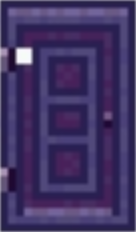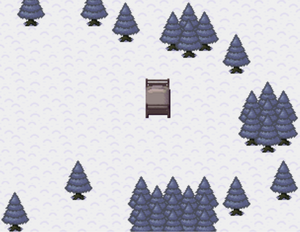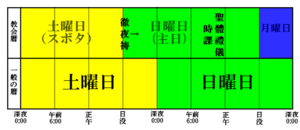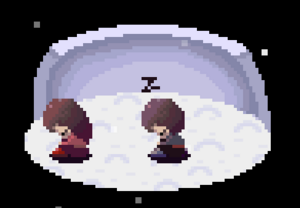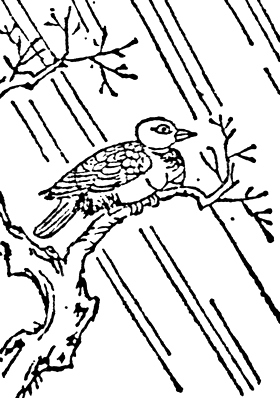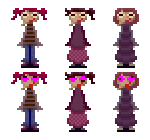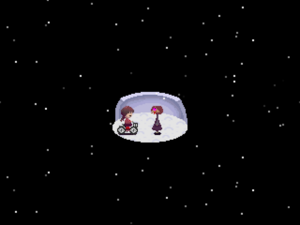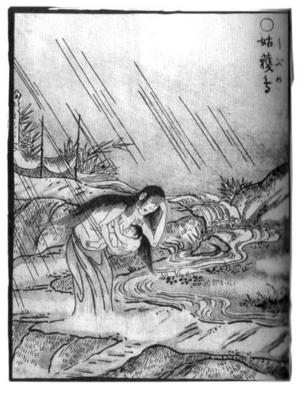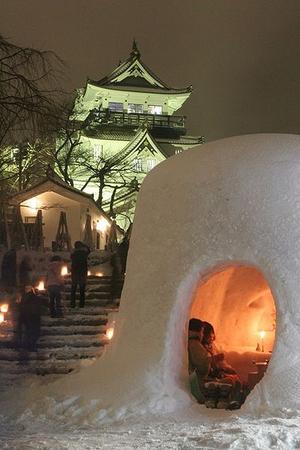>TenhGrey (Undo revision 9356 by 69.254.116.96 (talk)) |
No edit summary |
||
| (8 intermediate revisions by 5 users not shown) | |||
| Line 1: | Line 1: | ||
[[File: | [[File:YN Snow World.png|thumb|400px|link=http://yumenikki.wikia.com/wiki/Snow_World|left|Snow World(Advent Purple Door)]] | ||
| Line 31: | Line 31: | ||
==[[Snow World]]([http://en.wikipedia.org/wiki/Liturgical_colours Liturgical colours])== | ==[[Yume Nikki:Snow World|Snow World]]([http://en.wikipedia.org/wiki/Liturgical_colours Liturgical colours])== | ||
※"Snow World's door" is Liturgical colours Purple(Advent&Sacrament) and White(Christmastide&Easter Season)? | ※"Snow World's door" is Liturgical colours Purple(Advent&Sacrament) and White(Christmastide&Easter Season)? | ||
| Line 80: | Line 80: | ||
[[File:Bedroom(Snow_World).png|thumb|Snow World's Bedroom(Virgin Mary of "Christmas")]] | [[File:Bedroom(Snow_World).png|thumb|Snow World's Bedroom(Virgin Mary of "Christmas")]] | ||
※If "madotsuki" has suggested that it is a "pregnant woman" like Virgin Mary of "Christmas"? | ※If "[[Yume Nikki:Madotsuki|madotsuki]]" has suggested that it is a "pregnant woman" like Virgin Mary of "Christmas"? | ||
| Line 87: | Line 87: | ||
== | ==Snow World([http://en.wikipedia.org/wiki/Advent Advent])== | ||
※Relevance of "Christmas(White)" and "Advent(Purple)" | ※Relevance of "Christmas(White)" and "Advent(Purple)" | ||
| Line 99: | Line 99: | ||
Proponents of this new liturgical trend argue that purple is traditionally associated with solemnity and somberness, which is fitting to the repentant character of [http://en.wikipedia.org/wiki/Lent <u>Lent</u>]. On the 3rd Sunday of Advent, [http://en.wikipedia.org/wiki/Gaudete_Sunday <u>Gaudete Sunday</u>], rose may be used instead, referencing the rose used on [http://en.wikipedia.org/wiki/Laetare_Sunday <u>Laetare Sunday</u>], the 4th Sunday of Lent. | Proponents of this new liturgical trend argue that purple is traditionally associated with solemnity and somberness, which is fitting to the repentant character of [http://en.wikipedia.org/wiki/Lent <u>Lent</u>]. On the 3rd Sunday of Advent, [http://en.wikipedia.org/wiki/Gaudete_Sunday <u>Gaudete Sunday</u>], rose may be used instead, referencing the rose used on [http://en.wikipedia.org/wiki/Laetare_Sunday <u>Laetare Sunday</u>], the 4th Sunday of Lent. | ||
== | ==Snow World([http://en.wikipedia.org/w/index.php?title=Sacrament_of_Reconciliation&redirect=no Sacrament of Reconciliation])== | ||
The '''Sacrament of Penance and Reconciliation''' (commonly called '''Confession''', '''Reconciliation''' or '''Penance''') is one of seven [http://en.wikipedia.org/wiki/Sacraments_of_the_Catholic_Church <u>sacraments of the Catholic Church</u>] and [http://en.wikipedia.org/wiki/Sacred_mysteries <u>sacred mysteries</u>] of [http://en.wikipedia.org/wiki/Eastern_Christianity <u>Eastern Christianity</u>], in which the faithful obtain [http://en.wikipedia.org/wiki/Divine_Mercy <u>divine mercy</u>] for the [http://en.wikipedia.org/wiki/Sin <u>sins</u>] committed against God and neighbour and are reconciled with the [http://en.wikipedia.org/wiki/Koinonia <u>community</u>] of the [http://en.wikipedia.org/wiki/Christian_Church <u>Church</u>] (Cf. Vatican II, ''[http://en.wikipedia.org/wiki/Lumen_Gentium <u>Lumen Gentium</u>]'' 11 §2; [http://en.wikipedia.org/wiki/Catechism_of_the_Catholic_Church <u>CCC</u>] 1422).<sup class="reference" id="cite_ref-1">[http://en.wikipedia.org/wiki/Sacrament_of_Penance_(Catholic_Church)#cite_note-1 <u>[1</u>]]</sup> | The '''Sacrament of Penance and Reconciliation''' (commonly called '''Confession''', '''Reconciliation''' or '''Penance''') is one of seven [http://en.wikipedia.org/wiki/Sacraments_of_the_Catholic_Church <u>sacraments of the Catholic Church</u>] and [http://en.wikipedia.org/wiki/Sacred_mysteries <u>sacred mysteries</u>] of [http://en.wikipedia.org/wiki/Eastern_Christianity <u>Eastern Christianity</u>], in which the faithful obtain [http://en.wikipedia.org/wiki/Divine_Mercy <u>divine mercy</u>] for the [http://en.wikipedia.org/wiki/Sin <u>sins</u>] committed against God and neighbour and are reconciled with the [http://en.wikipedia.org/wiki/Koinonia <u>community</u>] of the [http://en.wikipedia.org/wiki/Christian_Church <u>Church</u>] (Cf. Vatican II, ''[http://en.wikipedia.org/wiki/Lumen_Gentium <u>Lumen Gentium</u>]'' 11 §2; [http://en.wikipedia.org/wiki/Catechism_of_the_Catholic_Church <u>CCC</u>] 1422).<sup class="reference" id="cite_ref-1">[http://en.wikipedia.org/wiki/Sacrament_of_Penance_(Catholic_Church)#cite_note-1 <u>[1</u>]]</sup> | ||
※Supposing there is an intention that the "[[Pink Sea]] is a baptism", the crime committed "after it is having turned off the electricity of the room of Poniko(Madotsuki's Sins?)", | ※Supposing there is an intention that the "[[Yume Nikki:Pink Sea|Pink Sea]] is a baptism", the crime committed "after it is having turned off the electricity of the room of Poniko(Madotsuki's Sins?)", | ||
[[File:Portal_igloo.png|thumb| | [[File:Portal_igloo.png|thumb|Pink Sea(Sacrament of Reconciliation)]]↓ | ||
"By this sacrament Christians are freed from sins committed after [http://en.wikipedia.org/wiki/Baptism <u>Baptism</u>].<sup class="reference" id="cite_ref-2">[http://en.wikipedia.org/wiki/Sacrament_of_Penance_(Catholic_Church)#cite_note-2 <u>[2</u>]]"</sup> | "By this sacrament Christians are freed from sins committed after [http://en.wikipedia.org/wiki/Baptism <u>Baptism</u>].<sup class="reference" id="cite_ref-2">[http://en.wikipedia.org/wiki/Sacrament_of_Penance_(Catholic_Church)#cite_note-2 <u>[2</u>]]"</sup> | ||
| Line 135: | Line 135: | ||
[[File:SekienYukionna.jpg|thumb|A Yuki-onna from Gazu Hyakki Yakō by Toriyama Sekien]] | [[File:SekienYukionna.jpg|thumb|A Yuki-onna from Gazu Hyakki Yakō by Toriyama Sekien]] | ||
==[[ | ==[[Yume Nikki:List of Characters#Yuki-onna|Yuki-onna]]([http://en.wikipedia.org/wiki/Yuki-onna Yuki-onna])== | ||
Yuki Onna <span style="font-weight: normal;">(雪女<sup>[http://en.wikipedia.org/wiki/Help:Installing_Japanese_character_sets <span class="t_nihongo_icon" style="font: bold 80%/normal sans-serif; padding: 0px 0.1em; color: rgb(0, 0, 238); text-decoration: none; font-size-adjust: none; font-stretch: normal;"><u>?</u></span>]</sup>, snow woman)</span> is a [http://en.wikipedia.org/wiki/Spiritual_being <u>spirit</u>] or [http://en.wikipedia.org/wiki/Y%C5%8Dkai <u>yōkai</u>] in [http://en.wikipedia.org/wiki/Japanese_folklore <u>Japanese folklore</u>]. She is a popular figure in [http://en.wikipedia.org/wiki/Japanese_literature <u>Japanese literature</u>], [http://en.wikipedia.org/wiki/Manga <u>manga</u>], and [http://en.wikipedia.org/wiki/Japanese_animation <u>animation</u>]. | Yuki Onna <span style="font-weight: normal;">(雪女<sup>[http://en.wikipedia.org/wiki/Help:Installing_Japanese_character_sets <span class="t_nihongo_icon" style="font: bold 80%/normal sans-serif; padding: 0px 0.1em; color: rgb(0, 0, 238); text-decoration: none; font-size-adjust: none; font-stretch: normal;"><u>?</u></span>]</sup>, snow woman)</span> is a [http://en.wikipedia.org/wiki/Spiritual_being <u>spirit</u>] or [http://en.wikipedia.org/wiki/Y%C5%8Dkai <u>yōkai</u>] in [http://en.wikipedia.org/wiki/Japanese_folklore <u>Japanese folklore</u>]. She is a popular figure in [http://en.wikipedia.org/wiki/Japanese_literature <u>Japanese literature</u>], [http://en.wikipedia.org/wiki/Manga <u>manga</u>], and [http://en.wikipedia.org/wiki/Japanese_animation <u>animation</u>]. | ||
| Line 151: | Line 151: | ||
In many stories, Yuki-onna appears to travelers trapped in [http://en.wikipedia.org/wiki/Snowstorm <u>snowstorms</u>], and uses her icy breath to leave them as frost-coated corpses. Other legends say she leads them astray so they simply die of exposure. Other times, she manifests holding a child. When a well-intentioned soul takes the "child" from her, they are frozen in place.<sup class="reference" id="cite_ref-a_3-1">[http://en.wikipedia.org/wiki/Yuki-onna#cite_note-a-3 <u>[3</u>]]</sup> | In many stories, Yuki-onna appears to travelers trapped in [http://en.wikipedia.org/wiki/Snowstorm <u>snowstorms</u>], and uses her icy breath to leave them as frost-coated corpses. Other legends say she leads them astray so they simply die of exposure. Other times, she manifests holding a child. When a well-intentioned soul takes the "child" from her, they are frozen in place.<sup class="reference" id="cite_ref-a_3-1">[http://en.wikipedia.org/wiki/Yuki-onna#cite_note-a-3 <u>[3</u>]]</sup> | ||
== | ==Yuki-onna([http://ja.wikipedia.org/wiki/%E9%9B%AA%E5%A5%B3 雪女])== | ||
[http://ja.wikipedia.org/wiki/%E9%9B%AA%E5%A5%B3#.E9.80.B8.E8.A9.B1 <u>2 逸話</u>] (2 Anecdote of Yuki-onna) | [http://ja.wikipedia.org/wiki/%E9%9B%AA%E5%A5%B3#.E9.80.B8.E8.A9.B1 <u>2 逸話</u>] (2 Anecdote of Yuki-onna) | ||
| Line 160: | Line 160: | ||
※Relevance of "姑獲鳥" and "雪ん子", from Anecdote of Yuki-onna(雪女) | ※Relevance of "姑獲鳥" and "雪ん子", from Anecdote of Yuki-onna(雪女) | ||
==[[Kamakurako]]([http://ja.wikipedia.org/wiki/%E9%9B%AA%E3%82%93%E5%AD%90 雪ん子])== | ==[[Yume Nikki:Kamakurako|Kamakurako]]([http://ja.wikipedia.org/wiki/%E9%9B%AA%E3%82%93%E5%AD%90 雪ん子])== | ||
※If "Kamakurako" is 雪ん子, she is child (embryo who is in a belly) of "Madotsuki(Yuki-onna)"? | ※If "Kamakurako" is 雪ん子, she is child (embryo who is in a belly) of "Madotsuki(Yuki-onna)"? | ||
| Line 169: | Line 169: | ||
*子供の姿の雪の精。雪童子(ゆきわらし) | *子供の姿の雪の精。雪童子(ゆきわらし) | ||
*[http://ja.wikipedia.org/wiki/%E6%97%A5%E6%9C%AC <u>日本</u>]の[http://ja.wikipedia.org/wiki/%E5%A6%96%E6%80%AA <u>妖怪</u>]・[http://ja.wikipedia.org/wiki/%E9%9B%AA%E5%A5%B3 <u>雪女</u>]の子供。[http://ja.wikipedia.org/wiki/%E9%9B%AA%E5%A5%B3#.E9.80.B8.E8.A9.B1 <u>雪女#逸話</u>]を参照。 | *[http://ja.wikipedia.org/wiki/%E6%97%A5%E6%9C%AC <u>日本</u>]の[http://ja.wikipedia.org/wiki/%E5%A6%96%E6%80%AA <u>妖怪</u>]・[http://ja.wikipedia.org/wiki/%E9%9B%AA%E5%A5%B3 <u>雪女</u>]の子供。[http://ja.wikipedia.org/wiki/%E9%9B%AA%E5%A5%B3#.E9.80.B8.E8.A9.B1 <u>雪女#逸話</u>]を参照。 | ||
<sup class="reference">[[File: | <sup class="reference">[[File:Madotsuki Kamakurako Comparison.png|thumb|Kamakurako(雪ん子)]]</sup> | ||
Children of Yuki-onna (Yuki-n-ko) | Children of Yuki-onna (Yuki-n-ko) | ||
*[[File:Ryoan_Ubume.jpg|thumb|寺島良安『和漢三才図会』より「姑獲鳥」]]accuracy of snow appearance of a child. Doji Snow (Yukiwarashi) | *[[File:Ryoan_Ubume.jpg|thumb|寺島良安『和漢三才図会』より「姑獲鳥」]]accuracy of snow appearance of a child. Doji Snow (Yukiwarashi) | ||
| Line 175: | Line 175: | ||
*Children of Yuki-onna specter of Japan. See story # fairy. | *Children of Yuki-onna specter of Japan. See story # fairy. | ||
==[[Toriningen]]([http://ja.wikipedia.org/wiki/%E5%A7%91%E7%8D%B2%E9%B3%A5 姑獲鳥])== | ==[[Yume Nikki:Toriningen|Toriningen]]([http://ja.wikipedia.org/wiki/%E5%A7%91%E7%8D%B2%E9%B3%A5 姑獲鳥])== | ||
[http://ja.wikipedia.org/wiki/%E5%A7%91%E7%8D%B2%E9%B3%A5#.E6.97.A5.E6.9C.AC.E3.81.AE.E4.BC.9D.E6.89.BF.E3.81.A8.E3.81.AE.E9.96.A2.E9.80.A3 <u>2 日本の伝承との関連</u>](2 The context of the tradition of Japan) | [http://ja.wikipedia.org/wiki/%E5%A7%91%E7%8D%B2%E9%B3%A5#.E6.97.A5.E6.9C.AC.E3.81.AE.E4.BC.9D.E6.89.BF.E3.81.A8.E3.81.AE.E9.96.A2.E9.80.A3 <u>2 日本の伝承との関連</u>](2 The context of the tradition of Japan) | ||
| Line 185: | Line 185: | ||
http://yumenikki.wikia.com/wiki/Snow_World(name)#Yuki-onna.28.E9.9B.AA.E5.A5.B3.29 | http://yumenikki.wikia.com/wiki/Snow_World(name)#Yuki-onna.28.E9.9B.AA.E5.A5.B3.29 | ||
== | ==Toriningen([http://ja.wikipedia.org/wiki/%E7%94%A3%E5%A5%B3 産女])== | ||
Ubume <span style="font-weight: normal;">(産女<sup>[http://en.wikipedia.org/wiki/Help:Installing_Japanese_character_sets <span class="t_nihongo_icon" style="font: bold 80%/normal sans-serif; padding: 0px 0.1em; color: rgb(0, 0, 238); text-decoration: none; font-size-adjust: none; font-stretch: normal;"><u>?</u></span>]</sup>)</span>, a [http://en.wikipedia.org/wiki/Japan <u>Japanese</u>] [http://en.wikipedia.org/wiki/Y%C5%8Dkai <u>yōkai</u>],<sup class="reference" id="cite_ref-1">[http://en.wikipedia.org/wiki/Ubume#cite_note-1 <u>[1</u>]]</sup> appears in folk stories and literature as an old woman or [http://en.wikipedia.org/wiki/Crone <u>Crone</u>], with a child in her arms, imploring the passerby to hold her infant, only to then disappear.<sup class="reference" id="cite_ref-2">[http://en.wikipedia.org/wiki/Ubume#cite_note-2 <u>[2</u>]]</sup> | Ubume <span style="font-weight: normal;">(産女<sup>[http://en.wikipedia.org/wiki/Help:Installing_Japanese_character_sets <span class="t_nihongo_icon" style="font: bold 80%/normal sans-serif; padding: 0px 0.1em; color: rgb(0, 0, 238); text-decoration: none; font-size-adjust: none; font-stretch: normal;"><u>?</u></span>]</sup>)</span>, a [http://en.wikipedia.org/wiki/Japan <u>Japanese</u>] [http://en.wikipedia.org/wiki/Y%C5%8Dkai <u>yōkai</u>],<sup class="reference" id="cite_ref-1">[http://en.wikipedia.org/wiki/Ubume#cite_note-1 <u>[1</u>]]</sup> appears in folk stories and literature as an old woman or [http://en.wikipedia.org/wiki/Crone <u>Crone</u>], with a child in her arms, imploring the passerby to hold her infant, only to then disappear.<sup class="reference" id="cite_ref-2">[http://en.wikipedia.org/wiki/Ubume#cite_note-2 <u>[2</u>]]</sup> | ||
[[File: | [[File:YN Igloo Toriningen.png|thumb|The Toriningen inside the Kamakurako's igloo.]] | ||
※”Kamakurako(baby)” was taken by ”Toriningen(産女)"? | ※”Kamakurako(baby)” was taken by ”Toriningen(産女)"? | ||
| Line 207: | Line 207: | ||
※" | ※"Madotsuki" was dropped in a pool of blood as "[[Yume Nikki:Hell|Hell]]", Because that "pregnant women(Madotsuki)" to be dead, It was "killed by Toriningen" or "Suicide by Madotsuki([[Yume Nikki:The Ending|The Ending]])"? | ||
http://yumenikki.wikia.com/wiki/Snow_World#Trivia | http://yumenikki.wikia.com/wiki/Snow_World#Trivia | ||
| Line 219: | Line 219: | ||
http://yumenikki.wikia.com/wiki/Snow_World(name)#Kamakurako.28.E9.9B.AA.E3.82.93.E5.AD.90.29[[File:Kamakura-yuki.jpg|thumb|[http://en.wikipedia.org/wiki/Yokote,_Akita Yokote]Park (横手公園)'s かまくら in [http://en.wikipedia.org/wiki/Akita_Prefecture Akita Prefecture](秋田県)]] | http://yumenikki.wikia.com/wiki/Snow_World(name)#Kamakurako.28.E9.9B.AA.E3.82.93.E5.AD.90.29[[File:Kamakura-yuki.jpg|thumb|[http://en.wikipedia.org/wiki/Yokote,_Akita Yokote]Park (横手公園)'s かまくら in [http://en.wikipedia.org/wiki/Akita_Prefecture Akita Prefecture](秋田県)]] | ||
== | ==Snow World([http://ja.wikipedia.org/wiki/%E3%81%8B%E3%81%BE%E3%81%8F%E3%82%89 かまくら])== | ||
かまくらとは[http://ja.wikipedia.org/wiki/%E7%A7%8B%E7%94%B0%E7%9C%8C <u>秋田県</u>]、[http://ja.wikipedia.org/wiki/%E6%96%B0%E6%BD%9F%E7%9C%8C <u>新潟県</u>]など[http://ja.wikipedia.org/wiki/%E6%97%A5%E6%9C%AC <u>日本</u>]の降雪地域に伝わる[http://ja.wikipedia.org/wiki/%E5%B0%8F%E6%AD%A3%E6%9C%88 <u>小正月</u>]の[http://ja.wikipedia.org/wiki/%E5%B9%B4%E4%B8%AD%E8%A1%8C%E4%BA%8B <u>伝統行事</u>]。 | かまくらとは[http://ja.wikipedia.org/wiki/%E7%A7%8B%E7%94%B0%E7%9C%8C <u>秋田県</u>]、[http://ja.wikipedia.org/wiki/%E6%96%B0%E6%BD%9F%E7%9C%8C <u>新潟県</u>]など[http://ja.wikipedia.org/wiki/%E6%97%A5%E6%9C%AC <u>日本</u>]の降雪地域に伝わる[http://ja.wikipedia.org/wiki/%E5%B0%8F%E6%AD%A3%E6%9C%88 <u>小正月</u>]の[http://ja.wikipedia.org/wiki/%E5%B9%B4%E4%B8%AD%E8%A1%8C%E4%BA%8B <u>伝統行事</u>]。 | ||
| Line 232: | Line 232: | ||
An [http://en.wikipedia.org/wiki/Altar altar] is prepared into the "家(house)" (snow cave) made from snow, and a water god is deified. | An [http://en.wikipedia.org/wiki/Altar altar] is prepared into the "家(house)" (snow cave) made from snow, and a water god is deified. | ||
※Relevance with the "a water god([http://en.wikipedia.org/wiki/Altar Altar])" and " | ※Relevance with the "a water god([http://en.wikipedia.org/wiki/Altar Altar])" and "Pink Sea([http://en.wikipedia.org/wiki/Altar_stone Altar stone])"? | ||
一般には、伝統行事で作られるものに限らず、雪洞自体が「かまくら」と呼ばれる。また、 新潟県の[http://ja.wikipedia.org/wiki/%E4%B8%AD%E8%B6%8A%E5%9C%B0%E6%96%B9 <u>魚沼地方</u>]では、同様の雪洞や行事のことを「'''[http://ja.wikipedia.org/wiki/%E3%81%BB%E3%82%93%E3%82%84%E3%82%89%E6%B4%9E <u>ほんやら洞</u>]'''」という。 | 一般には、伝統行事で作られるものに限らず、雪洞自体が「かまくら」と呼ばれる。また、 新潟県の[http://ja.wikipedia.org/wiki/%E4%B8%AD%E8%B6%8A%E5%9C%B0%E6%96%B9 <u>魚沼地方</u>]では、同様の雪洞や行事のことを「'''[http://ja.wikipedia.org/wiki/%E3%81%BB%E3%82%93%E3%82%84%E3%82%89%E6%B4%9E <u>ほんやら洞</u>]'''」という。 | ||
| Line 256: | Line 256: | ||
http://yumenikki.wikia.com/wiki/Snow_World(name)#Snow_World.28Liturgical_colours.29 | http://yumenikki.wikia.com/wiki/Snow_World(name)#Snow_World.28Liturgical_colours.29 | ||
[[Category: | [[Category:Yume Nikki theoretical discussions by Mt.kiki]] | ||
Latest revision as of 19:06, 11 April 2024
Snow World(Liturgical colours)
※"Snow World's door" is Liturgical colours Purple(Advent&Sacrament) and White(Christmastide&Easter Season)?
Post-1969 Rubrics
In the Roman Rite, as reformed by Pope Paul VI, the following colours are used.[1]
| Color | Obligatory Usage | Optional Usage (in lieu of prescribed obligatory colour) |
|---|---|---|
| Violet |
|
|
| White |
|
※Relevance of "Christmas" and "Snow World's Bedroom"
|
※If "madotsuki" has suggested that it is a "pregnant woman" like Virgin Mary of "Christmas"?
http://yumenikki.wikia.com/wiki/Snow_World(name)#Toriningen.28.E7.94.A3.E5.A5.B3.29
Snow World(Advent)
※Relevance of "Christmas(White)" and "Advent(Purple)"
Advent is a season observed in many Western Christian churches as a time of expectant waiting and preparation for the celebration of the Nativity of Jesus at Christmas.
1 Traditions 1.1 Liturgical Colors
See also: Liturgical colours
The usual liturgical colour in Western Christianity for Advent is either purple or blue.[4] The purple color is often used for hangings around the church, the vestments of the clergy, and often also the tabernacle.
Proponents of this new liturgical trend argue that purple is traditionally associated with solemnity and somberness, which is fitting to the repentant character of Lent. On the 3rd Sunday of Advent, Gaudete Sunday, rose may be used instead, referencing the rose used on Laetare Sunday, the 4th Sunday of Lent.
Snow World(Sacrament of Reconciliation)
The Sacrament of Penance and Reconciliation (commonly called Confession, Reconciliation or Penance) is one of seven sacraments of the Catholic Church and sacred mysteries of Eastern Christianity, in which the faithful obtain divine mercy for the sins committed against God and neighbour and are reconciled with the community of the Church (Cf. Vatican II, Lumen Gentium 11 §2; CCC 1422).[1]
※Supposing there is an intention that the "Pink Sea is a baptism", the crime committed "after it is having turned off the electricity of the room of Poniko(Madotsuki's Sins?)",
↓
"By this sacrament Christians are freed from sins committed after Baptism.[2]"
※And the purple door in the snowy world is connected with the pink(purple?) sea as a Liturgical colours of the faithful obtain divine mercy for the sins (Sacrament of Reconciliation) or the repentant character of Lent(Advent) from Poniko's House Event?
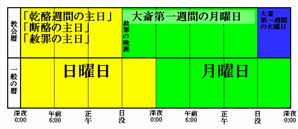
※Relevance of "Quinquagesima(Sacrament of Reconciliation) Sunday" and "Easter Sunday"
http://yumenikki.wikia.com/wiki/Effects(name)#Effects.28Easter_egg.29
Yuki-onna(Yuki-onna)
Yuki Onna (雪女?, snow woman) is a spirit or yōkai in Japanese folklore. She is a popular figure in Japanese literature, manga, and animation.
Yuki-onna appears on snowy nights as a tall, beautiful woman with long black hair and blue lips. Her inhumanly pale or even transparent skin makes her blend into the snowy landscape (as famously described in Lafcadio Hearn's Kwaidan: Stories and Studies of Strange Things). She sometimes wears a white kimono,[3] but other legends describe her as nude, with only her face and hair standing out against the snow.[4]
※Effects(Yuki-onna) can also make a snowstorms.
http://yumenikki.wikia.com/wiki/Effects#Yuki-onna
In many stories, Yuki-onna appears to travelers trapped in snowstorms, and uses her icy breath to leave them as frost-coated corpses. Other legends say she leads them astray so they simply die of exposure. Other times, she manifests holding a child. When a well-intentioned soul takes the "child" from her, they are frozen in place.[3]
Yuki-onna(雪女)
2 逸話 (2 Anecdote of Yuki-onna)
また、姑獲鳥との接点も持っており、吹雪の晩に子供(雪ん子)を抱いて立ち、通る人間に子を抱いてくれと頼む話が伝えられる。その子を抱くと、子がどんどん重くなり、人は雪に埋もれて凍死するという[3]。
In addition, we also have contact with "姑獲鳥", to ask me to talk to the man standing holding a child holding a child ("雪ん子") on the night of the snowstorm, is transmitted through. And embrace the child, the child becomes more and more serious, is that people freeze to death and buried in snow [3].
※Relevance of "姑獲鳥" and "雪ん子", from Anecdote of Yuki-onna(雪女)
Kamakurako(雪ん子)
※If "Kamakurako" is 雪ん子, she is child (embryo who is in a belly) of "Madotsuki(Yuki-onna)"?
雪ん子(ゆきんこ)
Children of Yuki-onna (Yuki-n-ko)
- accuracy of snow appearance of a child. Doji Snow (Yukiwarashi)
- Children of Yuki-onna specter of Japan. See story # fairy.
Toriningen(姑獲鳥)
2 日本の伝承との関連(2 The context of the tradition of Japan)
江戸時代初頭の日本では、日本の伝承上の妖怪「産女」が中国の妖怪である姑獲鳥と同一視され、「姑獲鳥」と書いて「うぶめ」と読むようになったが、これは産婦にまつわる伝承において、産女が姑獲鳥と混同され、同一視されたためと見られている[4]。
Although the supernatural creature "産女" on the tradition of Japan is identified with "姑獲鳥" which is a Chinese supernatural creature, writes it as "姑獲鳥" and came to read with "うぶめ" in Japan of the beginning of the Edo period(1603–1868), in the tradition related to a woman in labor, "産女" is confused with "姑獲鳥", and since it has been identified in the same category, this is seen [4].
※Relevance of "姑獲鳥" and "雪ん子", from Anecdote of Yuki-onna(雪女)
http://yumenikki.wikia.com/wiki/Snow_World(name)#Yuki-onna.28.E9.9B.AA.E5.A5.B3.29
Toriningen(産女)
Ubume (産女?), a Japanese yōkai,[1] appears in folk stories and literature as an old woman or Crone, with a child in her arms, imploring the passerby to hold her infant, only to then disappear.[2]
※”Kamakurako(baby)” was taken by ”Toriningen(産女)"?
唐の『酉陽雑俎』前集巻16および北宋の『太平広記』巻462に載せる「夜行遊女」は、
The "夜行遊女" who appears in the Part 16th of the collection of "酉陽雑俎" in 唐国, and the Part 462 of "太平広記" in 北宋,
人の赤子を奪うという夜行性の妖鳥で「或言産死者所化(或いは産死者の化せる所なりと言う)」とされる。
It is a bird of the nocturnal supernatural creature of taking people's baby,
It is considered as "或言産死者所化 (Or called the figure in which person with stillbirth transformed itself)."
※"Madotsuki" was dropped in a pool of blood as "Hell", Because that "pregnant women(Madotsuki)" to be dead, It was "killed by Toriningen" or "Suicide by Madotsuki(The Ending)"?
http://yumenikki.wikia.com/wiki/Snow_World#Trivia
産女が血染めの姿なのは、かつて封建社会では家の存続が重要視されていたため、死んだ妊婦は血の池地獄に堕ちると信じられていたことが由来とされる[1]。
In a feudal society, since importance was once attached to continuation of the house that "産女" is a blood-stained figure, it is considered as the origin that it was believed that the dead pregnant woman fell to the torture of Blood Pond [1].
※If "Kamakurako" is 雪ん子, she is child (embryo who is in a belly) of "Madotsuki(Yuki-onna)"?
http://yumenikki.wikia.com/wiki/Snow_World(name)#Kamakurako.28.E9.9B.AA.E3.82.93.E5.AD.90.29
Snow World(かまくら)
かまくらとは秋田県、新潟県など日本の降雪地域に伝わる小正月の伝統行事。
The traditional event of the Japanese New Year which gets across to the snowfall area in Japan, such as Akita Prefecture Akita Prefecture and Niigata Prefecture, with a "かまくら(Snow hut)".
※Relevance with the event Japanese "New Year"?
http://yumenikki.wikia.com/wiki/Number_World(name)#Mount_Fuji.28Hatsuyume.29
An altar is prepared into the "家(house)" (snow cave) made from snow, and a water god is deified.
※Relevance with the "a water god(Altar)" and "Pink Sea(Altar stone)"?
一般には、伝統行事で作られるものに限らず、雪洞自体が「かまくら」と呼ばれる。また、 新潟県の魚沼地方では、同様の雪洞や行事のことを「ほんやら洞」という。
Generally, what [ not only ] is made from a traditional event but the snow cave itself is called a "かまくら(snow hut)".
Moreover, in the method of a fish marshy place of Niigata Prefecture, the thing of the same snow cave or an event is called "ほんやら洞(Honyara-Cave)"
昭和11年(1936年)にこの地を訪れたドイツ人建築家ブルーノ・タウトが『日本美の再発見』の中で、子供たちが雪洞の中に祭壇を設けて水神を祀り餅などを食べたり鳥追いの歌を歌ったりして遊んだりする、この素朴で幻想的な情景を「まるで夢の国」と絶賛したこともあり、ますます盛んになり観光客が増えたという。
German builder Bruno Taut who visited this ground in Showa 11 (1936) in "rediscovery of Japanese beauty", Since this simple and visionary sight in which an altar is prepared into a snow cave, and a water god is deified, and rice cake etc. were eaten, or children sang the song of "鳥追い(A bird is driven off)", and played was extolled as "it is a country of a dream completely", it prospers increasingly and it is said that tourists increased in number.
酉小屋(とりごや) 積雪がほとんどない福島県いわき市で小正月に行われる伝統行事であり、無病息災を祈る風習[4] [5]
The customs of being a traditional event performed in Iwaki-shi, Fukushima which does not almost have snow coverage at the Japanese New Year, and wishing "無病息災(to be in good health)"
※Relevance with "無病息災(to be in good health) and Healing to a sick person" of the "酉小屋(Birdhouse)" and "Sacrament of the Sick"?
http://yumenikki.wikia.com/wiki/Snow_World(name)#Snow_World.28Liturgical_colours.29


